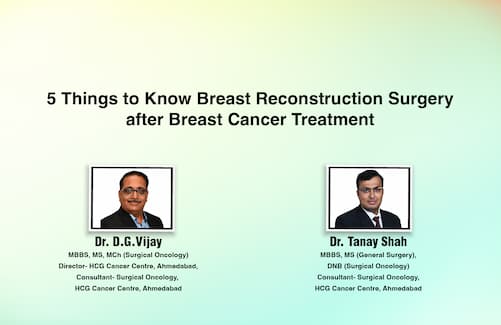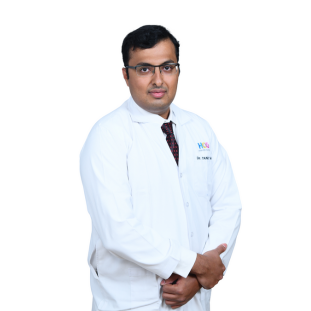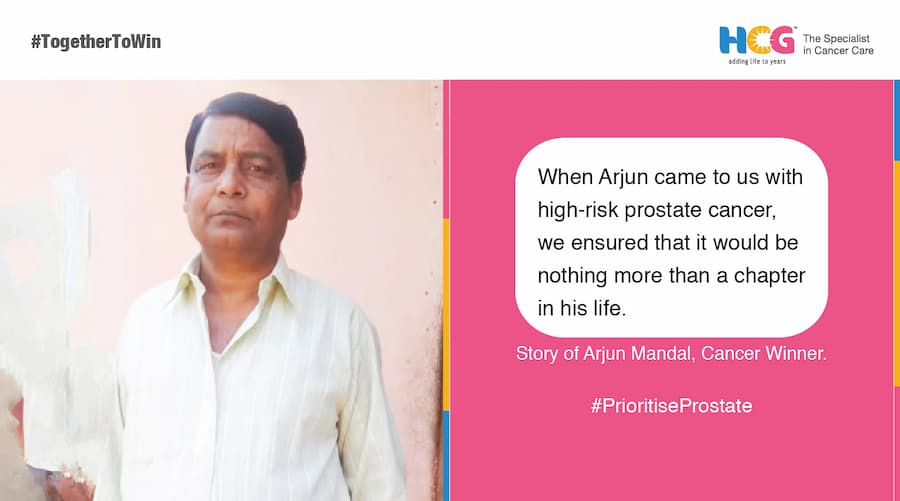
18 Oct, 2024

18 Oct, 2024

This article is medically reviewed by Dr. Tanay Shah, Consultant – Surgical Oncology, HCG Aastha Cancer Centre, Ahmedabad.
Breast reconstruction surgery, which is also known as oncoplastic breast surgery, is a surgical procedure that is available for women who have undergone breast cancer treatment, involving lumpectomy or complete mastectomy (whole breast removal).
Breast reconstruction surgeries are performed to restore the shape, appearance, size, and symmetry of one or both breasts to a near-normal state.
Breast reconstruction surgery can either be performed right after the breast cancer surgery (immediate reconstruction) or some years after the surgery (delayed reconstruction).
Breast reconstruction surgeries are broadly classified into two types:
Autologous breast reconstruction (flap reconstruction) is a surgical procedure in which the patient's own body tissues (skin, blood vessels, fat, and muscles) are used to reconstruct the whole breast or fix the partial breast defects.
The tissue for reconstruction is usually taken from the belly, but it can also be taken from the thighs and back (buttocks).
Occasionally, surgeons may move a flap from a nearly bodily site (pedicled flap). This flap retains its blood supply. Surgeons can also remove the flap from its blood supply and link it to blood vessels in the chest (free microvascular flap).
Flaps can be used for both partial breast reconstruction and whole breast reconstruction.
Following are some of the commonly used flaps for breast reconstruction:
DIEP (deep inferior epigastric perforator artery) free flap: This flap contains the skin, fat, and blood vessels from the lower belly. It also has the advantage of simultaneous abdominoplasty (tummy tuck). Here the blood supply is recreated by joining the flap vessels with vessels in the recipient area.
TRAM (transverse rectus abdominis muscle) pedicled flap: This flap contains the skin, fat, blood vessels, and muscles from the lower belly. It also provides the advantage of a tummy tuck. This flap is rotated on its own blood supply and doesn’t require recreating blood supply.
PAP (profunda artery perforator) flap: The PAP is a blood vessel that runs through the thigh. The flap contains this blood vessel and the skin and fat from the thigh.
TUG (transverse upper gracilis) flap: The TUG flap contains skin, blood vessels, fat, and muscles from the thigh.
The LD flap is taken from the region right below the shoulder blade and behind the armpit on the back. This flap comprises the skin, blood vessels, fat, and muscles. The LD flap is transposed to the breast area from the back while still remaining connected to its blood supply.
Implant reconstruction is a surgical procedure where the breast is reconstructed using saline or silicone implants. Sometimes, the implants may be combined with the patient's body tissues. Implants are considered mainly for whole breast reconstruction.
Following a mastectomy, implants are put beneath the skin or behind the chest wall muscle. Implant reconstruction is a two-stage surgical procedure. The surgeon first inserts a tissue expander under the skin that remains after the mastectomy or under the chest muscle in the first stage. This expander is filled with saline at regular intervals after surgery. In the second stage, the expander is replaced with an implant after the chest scar has healed.
Our center houses some of the best breast cancer specialists in Ahmedabad, who can devise breast reconstruction plans based on the individual needs of the patients.
Before recommending breast reconstruction surgery, we consider various factors, such as the stage of the disease, the size of the tumor, and the patient's overall condition.
Tumor-to-breast ratio is an important criterion that we consider. For candidates with a tumor-to-breast ratio of less than 20%, i.e., the tumor comprises less than 20% of the breast volume, breast conservation surgery is considered. In this case, an extensive reconstruction procedure may not be required.
However, if the tumor is more than 20% of the entire breast volume, reconstruction surgery is performed after the tumor is removed. This reconstruction surgery helps maintain the symmetry between both breasts.
In most cases, the specialists aim to perform reconstruction surgeries with superior precision. Therefore, there is very little chance that the patients will experience severe side effects. However, on rare occasions, there are chances where the patients may experience the following side effects:
In the case of whole breast reconstruction, there are chances of herniation at donor sites, i.e., the regions from where the tissue is extracted for breast reconstruction. This is a rare long-term side effect.
It has been found that cancer can recur after breast cancer surgery, whether or not the patient has undergone breast reconstruction surgery. It is important to note that breast reconstruction surgery does not increase or decrease the risk of cancer recurrence.
It is basically the disease’s biological type and stage responsible for recurrence rather than whether the patient has undergone reconstruction.
Also, breast cancer does not recur at the same site in most recurrent scenarios; they tend to recur in distant organs, namely the lungs, liver, bones, or brain.
Hence, cancer patients need to keep up follow-up appointments after their treatment. During follow-up visits, the specialists look for symptoms of cancer recurrence, check for side effects, and assess whether the patient is doing okay.
Patients should consider various factors before breast reconstruction surgery. Some of them include:
Patients may consider the following elements after breast reconstruction surgery:
As one of the leading hospitals for cancer treatment in India, HCG Aastha Cancer Centre, Ahmedabad, facilitates comprehensive care for different types of cancer.
When it comes to breast cancer, the hospital has a large and robust team of onco-breast surgeons who extensively specialize in the discipline of breast surgical oncology.
HCG Aastha provides the best treatment for breast cancer. We perform a broad spectrum of breast cancer surgeries, ranging from lumpectomy (breast conservation surgery) and modified radical/radical mastectomy to oncoplastic breast surgeries for partial and whole breast reconstruction procedures and sentinel LN biopsies and chemoport-insertion procedures.
Our team focuses on devising personalized and patient-centric treatment plans, which help us achieve positive clinical outcomes while ensuring a better quality of life for our patients.
Regular screening plays a pivotal role in the early detection and timely treatment of breast cancer. Besides early detection, getting in touch with the right specialist is equally essential. At HCG Aastha, we have some of Ahmedabad's best breast cancer specialists. They have vast experience in the diagnosis and treatment of breast cancer, breast conservation, and breast reconstruction and can help patients win over breast cancer—the right way, the first time.

Dr. Tanay Shah
Consultant – Surgical Oncology
MBBS, MS (General Surgery), DNB (Surgical Oncology)
Dr. Tanay Shah is a seasoned surgical oncology consultant who is available for consultations at HCG Aastha Cancer Centre, a top-ranking cancer hospital in Ahmedabad. He specializes in the surgical management of breast cancer, head and neck cancer, gynecological cancers, and GI oncological cancers. He is highly skilled in endoscopy, including upper gastrointestinal tract endoscopy, colonoscopy, fiberoptic laryngoscopy, and bronchoscopy. His expertise has been recognized by his peers, and he has participated in many oncology conferences and CMEs, which have significantly helped him hone his skills as a surgical oncologist.
To book an appointment with Dr. Tanay Shah, please click here.
